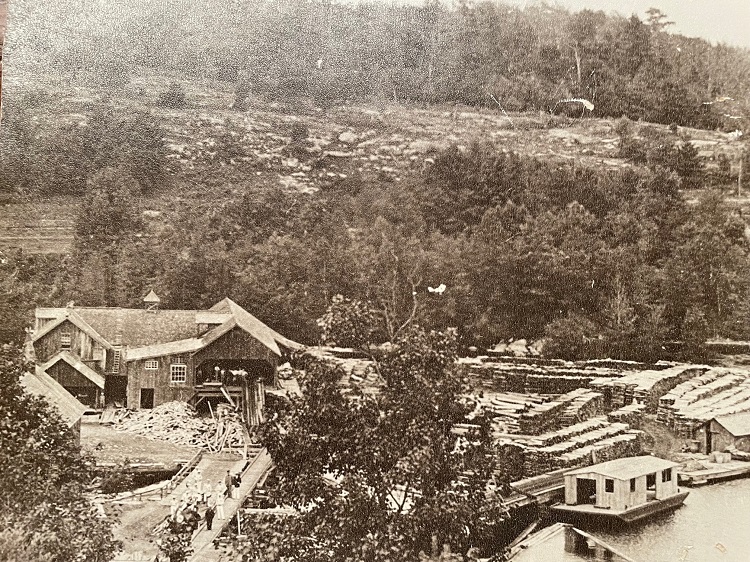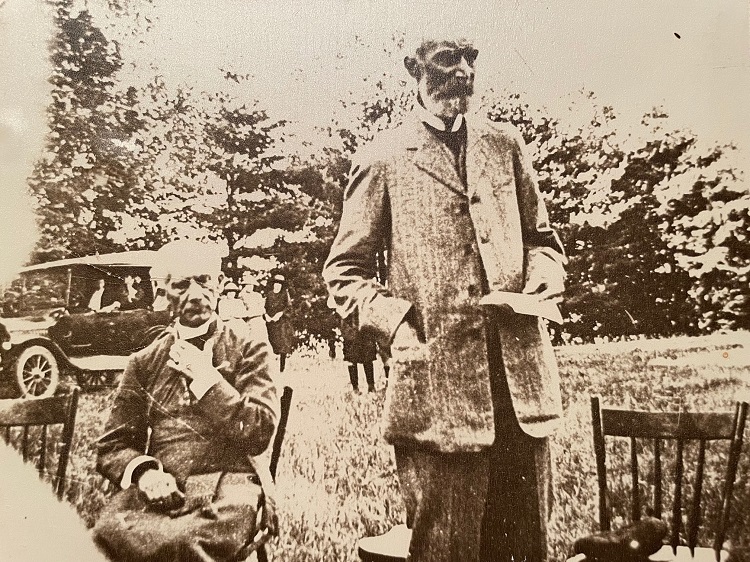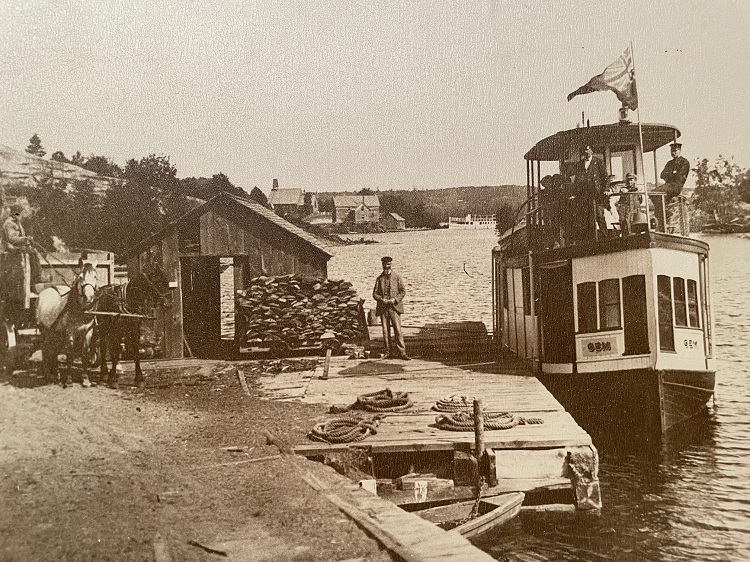It’s Wayback Wednesday, sponsored by Jamie Lockwood, broker/owner of Sutton Group Muskoka Realty!
Main photo: Albert Sydney Smith, his steamer the Gem, and a load of tan bark ready to be shipped to the tannery in Huntsville, circa 1905. (Photo courtesy of Ted Johnson)
One hundred and fifty years ago in July, intrepid traveller Albert Sydney Smith settled in what is now known as Port Sydney, and began forming the area into the idyllic village it is today.
Smith’s great nephew, Ted Johnson, is a retired lawyer and businessman and lifelong resident of Port Sydney. Johnson and his family still refer to Smith as “Uncle Albert,” and he works to keep Smith’s story and the history of Port Sydney alive.
Albert Sydney Smith was born in Hayesville, Waterloo County on May 9, 1846. He grew up in Stratford and after his father’s death in 1867, he became curious about the northern frontier lands of Ontario that were attracting so many people from across Canada and abroad. He made his first trip to the area in July 1871.
Johnson’s father, George Johnson, wrote the book Port Sydney Past, which contains a letter Smith wrote to a newspaper in July 1871, explaining his first impression of the area. In this letter, he describes the rocky land between Washago and Gravenhurst and says that “the rocks have a rather chilling effect on first sight on those who are not used to them.”
Though this terrain may have discouraged many who saw it, it did not have the same effect on Smith as he focused more on the benefits of the area. “He didn’t hesitate,” Johnson says of Smith. “He saw the downsides and challenges, but he also saw the opportunity.”
Seeing the potential the land had to offer, Smith began to work toward its development. The community of Mary Lake was already established, but Smith was drawn to the sawmill and falls to the south and believed there should be a community centred around them.

The Port Sydney sawmill in full production, circa 1890 (Photo courtesy of Ted Johnson)
Using a substantial inheritance from his father, Smith purchased the sawmill at the falls, as well as 200 acres of undeveloped land surrounding the dam including many lots along the south end of Mary Lake and the Muskoka River.
Smith laid out a subdivision plan for a village surrounding the mill. He conducted a survey of the land in the summer of 1872 and filed it at the Registry Office in 1873. This became plan No. 1 in the village of Port Sydney, which was evidently shortened from Port Sydney Smith, a name found to be too cumbersome.
This was only the beginning, however, of a long and arduous process in the development of the area, a process that Smith would maintain with steadfast ambition until his death.
After the survey was registered, the village quickly took off. The sawmill—powered by the dam and waterfall—became functional and started to expand. As the mill grew, so did the population, and lots were being sold with steady speed. “The clanking of the machinery in the mill was audible all throughout the village,” Johnson says. “Many would say it was ‘the sound of money.’”
Smith donated land and building materials for the Anglican and Presbyterian churches in the area, of which he was heavily involved. He taught at Sunday school, organized church activities, and took care of church finances. Smith also established a successful cheese factory, which further added to the economic value of the area.

Albert Sydney Smith addressing an Anglican Church function, possibly the annual Christ Church picnic at Port Sydney, circa 1918 (Photo courtesy of Ted Johnson)
Smith owned a small steamship that traveled between Port Sydney and Huntsville, as well as around Mary Lake. The steamer was used for various purposes: it would transport tanbark to the tannery in Huntsville, acted as a tug for towing saw logs around the lake, and would pick up the milk from farms and bring them to a dock still known as the “cheese dock,” which would then be transported to the cheese factory.

Albert Sydney Smith, his steamer the Gem, and a load of tan bark ready to be shipped to the tannery in Huntsville, circa 1905. The cheese factory and the Anglican Church can be seen in the background. (Photo courtesy of Ted Johnson)
Smith’s most ambitious endeavour, perhaps, was the railway, a vision that never quite came to fruition. During this time, the railway ended in Washago and he had plans to extend it further north, to North Bay and Lake Nippissing. Smith wanted the railway to extend through Port Sydney to the east of Mary Lake. “Had this been successful,” Johnson says, “Port Sydney would have been the economic head of the area.”
The railway went to Huntsville instead, due in part to the easier route and the fact the land had already been surveyed. This railway made Huntsville the centre of economic expansion.
By 1920, the mill was running out of wood within a reasonable distance and other mills in the area were becoming more successful. By the mid 1920s, the mill went out of business and the cheese factory closed down. Smith, however, saw these businesses through until the bitter end.
In his final days, Johnson says that the village knew Smith as a “tall man with a big white beard who was very distinguished in the community.” Smith died in 1925, and the church bell rang for half an hour to signal to the village the passing of its namesake.
Johnson points out that if Smith could see Port Sydney today, he would be very pleased.
“He would be happy to see it is still there and would be impressed with the community spirit,” Johnson says. “He would also look at it and wonder what might have been if the railway was successful, and chuckle at the fact that his relatives are still living here and appreciating the fact that he brought us all to this area.”
Three family branches of Smith’s descendants still live in the area, and one of his great-great-great-nephews is named Sydney, after him. The memory of Smith is kept alive not only by the village that bears his name, but by the remarkable and timeless community that he created.
See more Wayback Wednesday photos here.
Don’t miss out on Doppler!
Sign up here to receive our email digest with links to our most recent stories.
Local news in your inbox so you don’t miss anything!
Click here to support local news




Ray Vowels says
WOW great article I sure learned a lot that i never even heard about before . Lived in Port for a couple of years back in the 60s loved it but could not find anything for sale that I could afford so moved north of Huntsville.
Bill Beatty says
Port Sydney: A “Distinct Society ” !
Nancy Long says
I love the picture of the cheese dock….I just wish I could find it in the real world! Where oh where is it?
Wendy Oke says
I am looking for any photos of my husband’s great grandfather, William Henry Morgan, who was a friend of Albert Sydney Smith’s from Haysville. He built the Anglican Christ Church and Morgan St. is named after him. There is only one family photo of Wm. Morgan, and we would dearly love to have any more in existence. We are also trying to locate the baptismal font Wm. built when he built the Newholm Church on the Rumball property at Brunel.
Brian Steele says
My wife and I co-owned a cottage in Port Sydney for many years, a place that’s very close to our hearts. During that time, we lived in Huntsville (Brunel) for almost a decade. Last year, we moved to Stratford.
Yesterday evening, when I was walking past St. James Church in Stratford, I went off the path to look at some of the old tombstones that lie flat in the ground. The first one I noticed was Sydney Smith, died 1967. I wondered, could this be Sydney Smith of Port Sydney?
I probably should have realized that he died too early to be the founder, but I’m amazed to learn it’s the tombstone of his father.
Thanks for the history lesson. In some way, I feel like I still have a bit of Port Sydney close by.
Brian Steele says
Correction: The tombstone reads, Sydney Smith, died 1867.